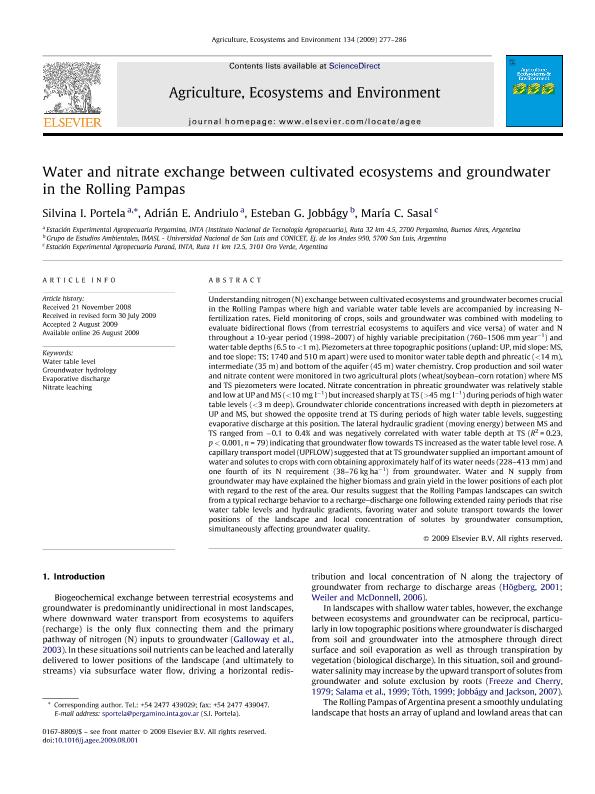Mostrar el registro sencillo del ítem
dc.contributor.author
Portela, Silvina Isabel

dc.contributor.author
Andriulo, Adrian Enrique

dc.contributor.author
Jobbagy Gampel, Esteban Gabriel

dc.contributor.author
Sasal, María Carolina

dc.date.available
2021-03-03T19:28:29Z
dc.date.issued
2009-01
dc.identifier.citation
Portela, Silvina Isabel; Andriulo, Adrian Enrique; Jobbagy Gampel, Esteban Gabriel; Sasal, María Carolina; Water and nitrate exchange between cultivated ecosystems and groundwater in the Rolling Pampas; Elsevier Science; Agriculture, Ecosystems and Environment; 134; 3-4; 1-2009; 277-286
dc.identifier.issn
0167-8809
dc.identifier.uri
http://hdl.handle.net/11336/127343
dc.description.abstract
Understanding nitrogen (N) exchange between cultivated ecosystems and groundwater becomes crucial in the Rolling Pampas where high and variable water table levels are accompanied by increasing N-fertilization rates. Field monitoring of crops, soils and groundwater was combined with modeling to evaluate bidirectional flows (from terrestrial ecosystems to aquifers and vice versa) of water and N throughout a 10-year period (1998-2007) of highly variable precipitation (760-1506 mm year-1) and water table depths (6.5 to <1 m). Piezometers at three topographic positions (upland: UP, mid slope: MS, and toe slope: TS; 1740 and 510 m apart) were used to monitor water table depth and phreatic (<14 m), intermediate (35 m) and bottom of the aquifer (45 m) water chemistry. Crop production and soil water and nitrate content were monitored in two agricultural plots (wheat/soybean-corn rotation) where MS and TS piezometers were located. Nitrate concentration in phreatic groundwater was relatively stable and low at UP and MS (<10 mg l-1) but increased sharply at TS (>45 mg l-1) during periods of high water table levels (<3 m deep). Groundwater chloride concentrations increased with depth in piezometers at UP and MS, but showed the opposite trend at TS during periods of high water table levels, suggesting evaporative discharge at this position. The lateral hydraulic gradient (moving energy) between MS and TS ranged from -0.1 to 0.4% and was negatively correlated with water table depth at TS (R2 = 0.23, p < 0.001, n = 79) indicating that groundwater flow towards TS increased as the water table level rose. A capillary transport model (UPFLOW) suggested that at TS groundwater supplied an important amount of water and solutes to crops with corn obtaining approximately half of its water needs (228-413 mm) and one fourth of its N requirement (38-76 kg ha-1) from groundwater. Water and N supply from groundwater may have explained the higher biomass and grain yield in the lower positions of each plot with regard to the rest of the area. Our results suggest that the Rolling Pampas landscapes can switch from a typical recharge behavior to a recharge-discharge one following extended rainy periods that rise water table levels and hydraulic gradients, favoring water and solute transport towards the lower positions of the landscape and local concentration of solutes by groundwater consumption, simultaneously affecting groundwater quality.
dc.format
application/pdf
dc.language.iso
eng
dc.publisher
Elsevier Science

dc.rights
info:eu-repo/semantics/openAccess
dc.rights.uri
https://creativecommons.org/licenses/by-nc-sa/2.5/ar/
dc.subject
EVAPORATIVE DISCHARGE
dc.subject
GROUNDWATER HYDROLOGY
dc.subject
NITRATE LEACHING
dc.subject
WATER TABLE LEVEL
dc.subject.classification
Otras Ciencias de la Tierra y relacionadas con el Medio Ambiente

dc.subject.classification
Ciencias de la Tierra y relacionadas con el Medio Ambiente

dc.subject.classification
CIENCIAS NATURALES Y EXACTAS

dc.title
Water and nitrate exchange between cultivated ecosystems and groundwater in the Rolling Pampas
dc.type
info:eu-repo/semantics/article
dc.type
info:ar-repo/semantics/artículo
dc.type
info:eu-repo/semantics/publishedVersion
dc.date.updated
2020-09-24T14:25:05Z
dc.journal.volume
134
dc.journal.number
3-4
dc.journal.pagination
277-286
dc.journal.pais
Países Bajos

dc.journal.ciudad
Amsterdam
dc.description.fil
Fil: Portela, Silvina Isabel. Instituto Nacional de Tecnología Agropecuaria. Centro Regional Buenos Aires Norte. Estación Experimental Agropecuaria Pergamino; Argentina
dc.description.fil
Fil: Andriulo, Adrian Enrique. Instituto Nacional de Tecnología Agropecuaria. Centro Regional Buenos Aires Norte. Estación Experimental Agropecuaria Pergamino; Argentina
dc.description.fil
Fil: Jobbagy Gampel, Esteban Gabriel. Consejo Nacional de Investigaciones Científicas y Técnicas. Centro Científico Tecnológico Conicet - San Luis. Instituto de Matemática Aplicada de San Luis "Prof. Ezio Marchi". Universidad Nacional de San Luis. Facultad de Ciencias Físico, Matemáticas y Naturales. Instituto de Matemática Aplicada de San Luis "Prof. Ezio Marchi"; Argentina
dc.description.fil
Fil: Sasal, María Carolina. Instituto Nacional de Tecnología Agropecuaria. Centro Regional Buenos Aires Norte. Estación Experimental Agropecuaria Pergamino; Argentina
dc.journal.title
Agriculture, Ecosystems and Environment

dc.relation.alternativeid
info:eu-repo/semantics/altIdentifier/doi/https://doi.org/10.1016/j.agee.2009.08.001
dc.relation.alternativeid
info:eu-repo/semantics/altIdentifier/url/https://www.sciencedirect.com/science/article/abs/pii/S0167880909002291?via%3Dihub
Archivos asociados
